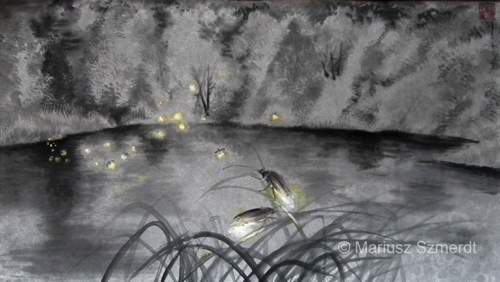142. The "Insect" Radical: 虫
In life, insects are notoriously hard to pin down, buzzing around to and fro and causing great distress to humans. It's no surprise that we say that someone or something "bugs" us.
But the "insect" kanji is a different animal altogether. It's quite straightforward in nearly every way. For instance, the shape of this six-stroke radical does not change from character to character. It always looks like 虫.
Names of the "Insect" Radical
The English name of this radical is "insect," although "bug" works fine, too. Just as the Japanese read the autonomous kanji 虫 as むし, they call the radical むし. When it's on the left, むしへん is appropriate.
Differentiating This Radical from Another
It's possible to spot our radical inside 風, but it's not really there. That whole shape constitutes radical 182, the "wind" radical.
Joyo Kanji with Buggy Meanings
In the following Joyo kanji, 虫 is the on-duty radical, which is no surprise, given their buggy meanings:
虫 (56: insect, bug)
蚊 (1056: mosquito)
蛍 (1200: firefly; fluorescent)
蜂 (2109: bee; hornet; wasp)
In terms of etymology, 虫 stays true to its insect meaning in all those characters, as well as in this one:
蚕 (688: silkworm)
It makes sense to find an insect in the next kanji, where 虫 is the on-duty radical according to most sources (but not all):
蜜 (2116: honey; nectar)
Kanjigen says that this 虫 means "insect (specifically a bee)" and that the remainder of the character means "to shut something in." A thing bees store? That's honey in a honeycomb!

Photo Credit: Kevin Hamilton
Our radical appears twice in a row! We find it twice in 蜂蜜 (はちみつ: honey), which breaks down as bee + honey. As 専門店 (せんもんてん) means "specialty shop," this is a shop specializing in honey.
The On-Duty Radical as "Snake"
It's more surprising to find the on-duty 虫 in the kanji for this creature:
蛇 (1341: snake)
The 它 in 蛇 started out as a pictograph of a “snake with a large head,” likely a cobra, says Henshall in his newer edition. People then borrowed 它 to represent a homophone meaning “others.” To distinguish between the two words, the ancient Chinese eventually added 虫 to the left, producing 蛇. Henshall defines 虫 as "insect, worm, snake" in this context.
The on-duty 虫 radical means "snake" even in these kanji:
蛮 (1722: barbarian)
Henshall says that an early form of this character represented a certain region in southern China. The ancient Chinese added 虫 to the mix, intending for this radical to symbolize a snake associated with that region. Only later did this character come to mean "barbarity" or "barbarism."
虹 (2090: rainbow)
Kanjigen says the 虫 means “snake," whereas 工 means “to penetrate,” also contributing sound to this character. A rainbow is like a huge snake penetrating the sky, says Kanjigen. Gee, I always thought rainbows were lovely to behold, not horrible and reptilian!

Photo Credit: Mariusz Szmerdt
Neither a Snake Nor an Insect
If it seems odd that 虫 would mean "snake, insect" in the following character, that's because it actually doesn't!
融 (1872: to dissolve, melt)
According to Henshall, the left side is a "large pot on a stand." Even though 虫 is the on-duty radical here, the right side supplies only the sound of hissing steam. "To dissolve, melt" is a borrowed or associated meaning.
A Component in Several Joyo Kanji
Finally, we come to a handful of kanji in which 虫 is off duty. Even so, we can see that some have buggy meanings, including this one:
繭 (1223: cocoon)
Let's look at the others briefly:
強 (100: strong)
The insect meaning actually holds fast here! Henshall says that this character represents a "big, strong insect that pierces," a reference to the "horsefly." Who'd have guessed?!
騒 (1530: to make noise)
Henshall says that the right side means "troublesome insect," also acting phonetically to express "confusion."
濁 (1558: muddiness; impurity; voiced)
Everything to the right of the "water" radical 氵 means "caterpillar," which acts phonetically to express "impure" and may also lend connotations of "unpleasant," says Henshall.
As for two final characters, 虫 is only a modern addition to these shapes:
独 (763: alone, single)
触 (1428: to touch)
However, it's worth noting that both used to contain caterpillars, as well!
|
A Chinese sign in Hong Kong includes 蟲, a stack of three insect radicals! This is the old form of 虫 and means “insects, worms.” According to Kanjigen, 蟲 and 虫 were originally different kanji; 蟲 meant “insects, worms," whereas 虫 meant “snake." However, 虫 came to be used as a simplified version of 蟲. In Japanese, this pyramidal shape is a non-Joyo kanji meaning "bug, insect, temper." It has the kun-yomi of むし. The radical, of course, is 虫. Photo Credit: Eve Kushner |
An Unexpected Word
I can't close this discussion without sharing a most unexpected word:
虫供養 (むしくよう: Buddhist memorial service for the bugs killed by farmers plowing their fields)
There. Now you can go.


